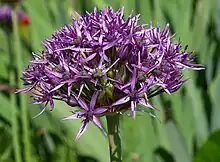| Purple onion Granat-Kugellauch | |
|---|---|
 | |
| Allium atropurpureum | |
| Scientific classification | |
| Kingdom: | Plantae |
| Clade: | Tracheophytes |
| Clade: | Angiosperms |
| Clade: | Monocots |
| Order: | Asparagales |
| Family: | Amaryllidaceae |
| Subfamily: | Allioideae |
| Genus: | Allium |
| Subgenus: | Allium subg. Melanocrommyum |
| Species: | A. atropurpureum |
| Binomial name | |
| Allium atropurpureum | |
| Synonyms[1] | |
|
Allium nigrum var. atropurpureum (Waldst. & Kit.) Vis. | |
Allium atropurpureum is a plant species native to Hungary, the Balkans, and Turkey.[1] It is widely grown as an ornamental for its rich, deep purple flowers.[2][3]
Description
Allium atropurpureum grows from a spherical to egg-shaped bulb. Its scape is up to 100 cm (39 in) tall. The green,[4] leaves are broadly linear, up to 7 mm across, tapering at the tip.[5] It blooms in late spring and early summer,[4] the umbel is hemispherical, with many dark purple flowers. Ovary is very dark purple, almost black.[5][6] It has a strong onion or garlic scent.[4]
Taxonomy
It was published and described by Franz de Paula Adam von Waldstein and Pál Kitaibel in 'Descr. Icon. Pl. Hung.' Vol.1 on page 16, in 1800.[5][7][8]
The specific epithet atropurpureum, refers to the Latin term of 'deep purple, blackish-purple',[9] referring to the flower colour.
The species formerly included; Allium atropurpureum var. hirtulum Regel, which was coined in 1875,[10] referring to a Central Asian plant, now known as Allium stipitatum Regel.[1]
Distribution and habitat
It is native to temperate regions of Europe and Asia.[1][11]
Range
It is found in Asia, within Turkey; in Europe, it is found within Bulgaria, Hungary, Croatia, and Romania.[11]
Habitat
It prefers to grow on cultivated ground and in dry open spaces.[12]
Cultivars
A popular bulb sold by many nurseries is Allium ‘Firmament’, which was developed by breeder J. Bijl in 1971 from a cross between Allium atropurpureum and Allium cristophii.[13]
References
- 1 2 3 4 Kew World Checklist of Selected Plant Families
- ↑ Visiani, Roberto de. 1842. Flora Dalmatica 1: 136.
- ↑ Bailey, L.H. & E.Z. Bailey. 1976. Hortus Third i–xiv, 1–1290. MacMillan, New York.
- 1 2 3 "Allium atropurpureum". rhs.org.uk. Retrieved 20 November 2017.
- 1 2 3 Waldstein, Franz de Paula Adam von & Pál Kitaibel. 1800. Descriptiones et icones plantarum rariorum Hungariae 1: 16.
- ↑ "Őzhatay, Neriman Fatma & Ilker Genç 2013. Allium cyrilli complex (sect. Melanocrommyum ) in Turkey. Turkish Journal of Botany 37:39.45" (PDF). Archived from the original (PDF) on 2014-03-28. Retrieved 2014-03-28.
- ↑ "Allium atropurpureum Waldst. & Kit. is an accepted name". 23 March 2012. plantlist.org. Retrieved 20 November 2017.
- ↑ "Alliaceae Allium atropurpureum Waldst. & Kit". ipni.org. Retrieved 20 November 2017.
- ↑ Allen J. Coombes The A to Z of Plant Names: A Quick Reference Guide to 4000 Garden Plants, p. 37, at Google Books
- ↑ Regel, Eduard August von 1875. Trudy Imperatorskago S.-Peterburgskago Botaničeskago Sada 3(2): 248 in German,
- 1 2 "Taxon: Allium atropurpureum Waldst. & Kit". ars-grin.gov. Retrieved 20 November 2017.
- ↑ "Allium atropurpureum". pacificbulbsociety.org. Retrieved 20 November 2017.
- ↑ Bourne, Val (25 September 2013). "How to grow alliums". saga.co.uk. Retrieved 20 November 2017.